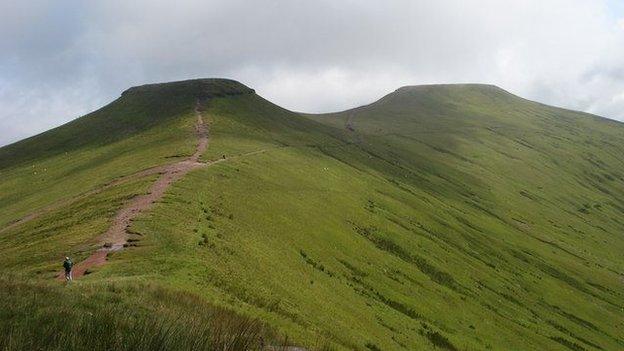Meet Hart: Wales' specialist major incidents ambulance team
- Published
The team simulate rescuing a casualty from a confined space
A man called Neil is trapped in a collapsed building.
Wales' Hazardous Area Response Team (Hart) needs to get the casualty to hospital within the "golden hour", giving him the best chance of surviving his injuries.
Fortunately, "Neil" is a mannequin and the "collapsed building" is a pile of rubble at the team's Bridgend headquarters.
On a damp and grey Monday morning at the Brynmenyn industrial estate, white watch, one of Hart's seven teams has begun a week-long training programme. The elite team train for one week in every seven.
All experienced ambulance staff, they are specially trained to attend hostile or hard-to-access incidents and provide medical treatment to casualties from the moment they arrive, giving patients a greater chance of survival.
Before the service was created in 2012, paramedics had to wait for firefighters to bring victims out to safety before providing medical treatment.
Responding to chemical, biological, radioactive, nuclear, firearm and terrorist incidents is also part of the team's brief.
Difficult terrain, sleep deprivation, exhaustion from wearing heavy suits and dehydration caused by some of the breathing kit can make already challenging environments even more difficult.
Hart's white watch has been working together since the service was created three years ago and there is a strong sense of camaraderie amongst the team, with lots of jokes at each other's expense doing the rounds.
Together, they have attended some of Wales' most high profile incidents.
'Harrowing' search
In 2012 Hart took part in the search for five-year-old April Jones from Machynlleth.
Clinical team leader Gavin Quinn, 46, said the search in Powys was particularly "physically and mentally demanding" for the team.
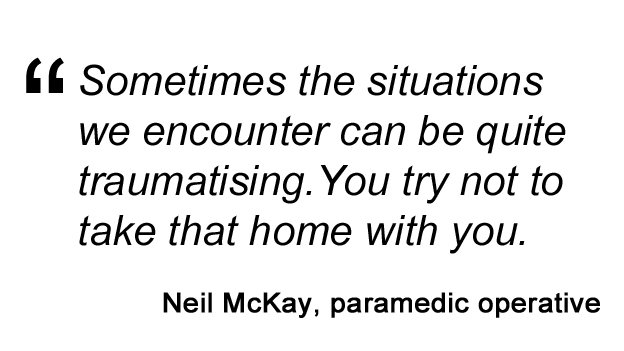
Paramedic operative Neil McKay, 40, agreed: "It was quite harrowing, quite surreal really.
"After seeing it for so long on the TV, to actually go to Machynlleth and assist with the search was hard.
"There was a lot of trekking through mountains and the terrain was quite difficult and involved water and cave searches.
"Her mum was there helping to make food for everybody."
April's body was never found, but bone fragments discovered at a cottage near Machynlleth helped convict 46-year-old Mark Bridger of murder.
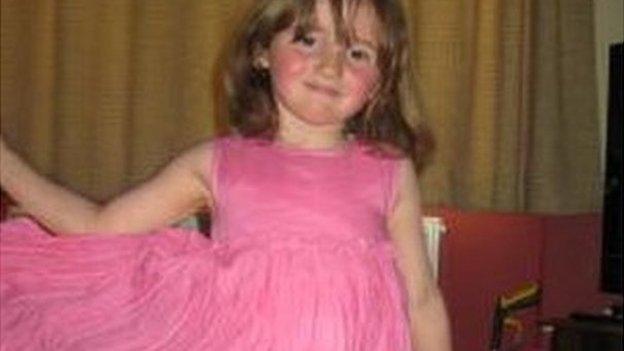
Hart was involved in the search for Machynlleth five-year-old April Jones
In 2013 Hart rescued casualties from floods in Rhyl, Denbighshire, and attended Rhws Primary School, Vale of Glamorgan, after an out-of-control car injured a school lollipop lady and five children.
More recently, in June the team was called to a rock fall in Llantwit Major, Vale of Glamorgan which killed a 23-year-old woman and in July they went to the Brecon Beacons after lightning strikes left two men dead.
Day-to-day they witness catastrophic accidents and family tragedies, from a man who has jumped in front of a train, a teenager killed in a car crash to a father killed in an industrial accident.
Between April 2014 and the end of March 2015, Hart attended 2,226 calls, ranging from multiple vehicle collisions to natural disasters.
'Traumatising'
Despite the distressing incidents they regularly encounter, the team said they had never taken up the offer of counselling.
"Sometimes the situations we encounter can be quite traumatising", Mr McKay said.
"You try not to take that home with you. Instead we all talk about it in the station and have a good chat."
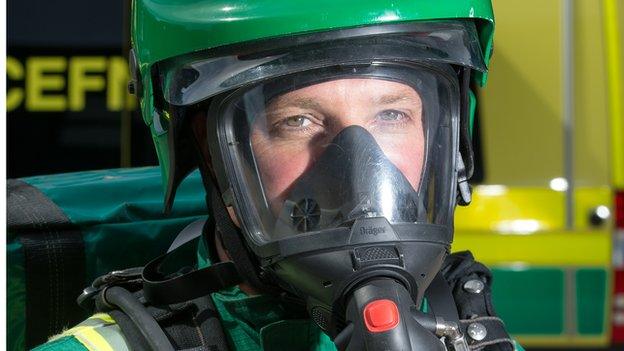
The team uses specialist equipment such as breathing apparatus
Deputy team leader Martyn Sullivan, the oldest member of Hart at 56, said the call-outs involving children could be the toughest.
"I was called out years ago to a woman with two kids. One of them had stopped breathing," he said.
"I worked on the child for a long time but it was too late. That was hard. I hadn't long had my own kid."
He has come up with a unique way of dealing with children who find themselves in a stressful environment; he always carries a puppet called Sweep, from The Sooty Show, which he said can help him get on a level with a child and provide a welcome distraction.
Stamina and fitness
Every six months the team's stamina and fitness is tested.
Each team member has 14 minutes to complete a series of tasks while wearing full incident ground kit.
It involves a step-up test, a distance walk while wearing a 25kg (55lb) vest, a weighted mannequin drag and a dexterity test.

Emergency medical technician Rebecca Owen, the only woman in white watch, recreates the team's biannual fitness assessment
But what of Neil, the man trapped in the collapsed building?
Mr Sullivan explains: "We located the casualty who had a fractured leg and arm.
"We maintained the airways and the patient was packaged. From the time the team went in it took 16 minutes to get the patient out.
"This wouldn't have been possible years ago. Before we would have had to rely on the fire brigade, which did a good job, but now we can take all our equipment and start medical treatment from the moment we arrive, giving the patient a greater opportunity of survival.
"Sixteen minutes to go in, package a patient and get them in an ambulance, you can't ask for better than that."
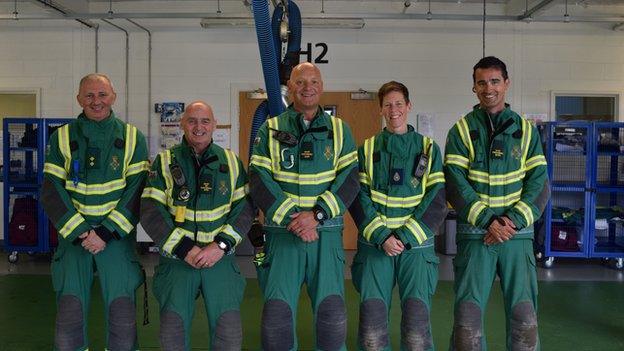
Left to right: Clinical team leader Gavin Quinn, deputy team leader Martyn Sullivan, paramedic operative David Woo key, emergency medical technician Rebecca Owen and paramedic operative Neil McKay
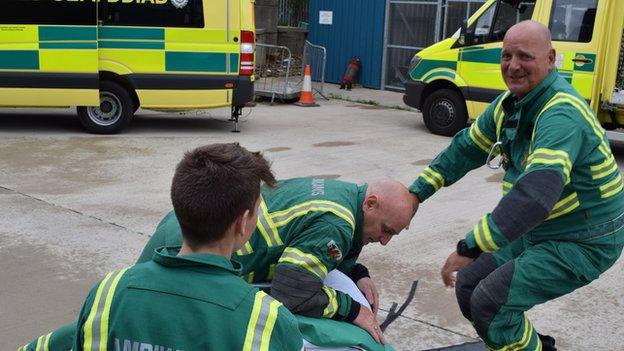
The team enjoy a joke at the headquarters
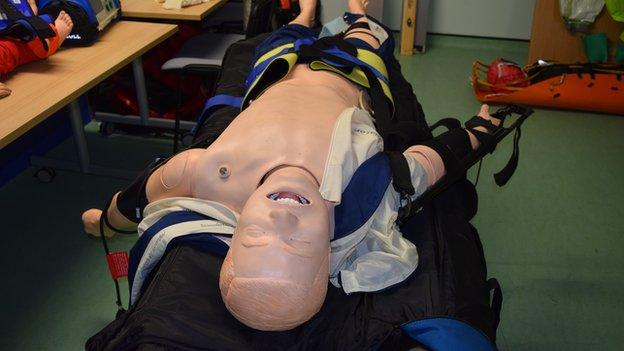
One of several mannequins used in medical training
- Published2 October 2012
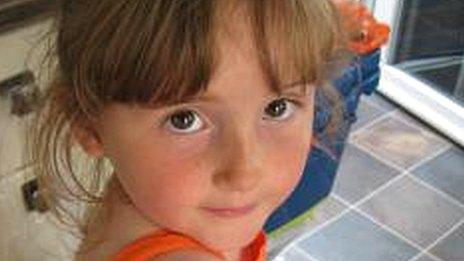
- Published6 May 2015

- Published19 June 2015
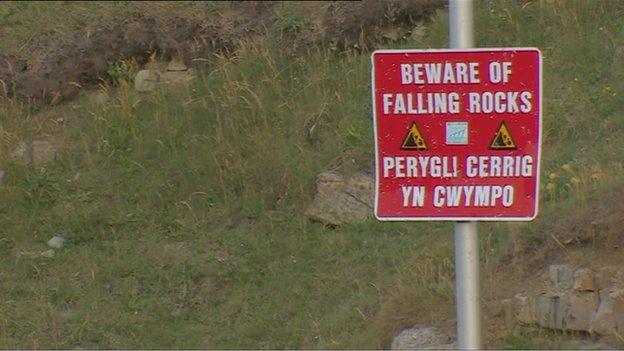
- Published5 July 2015
